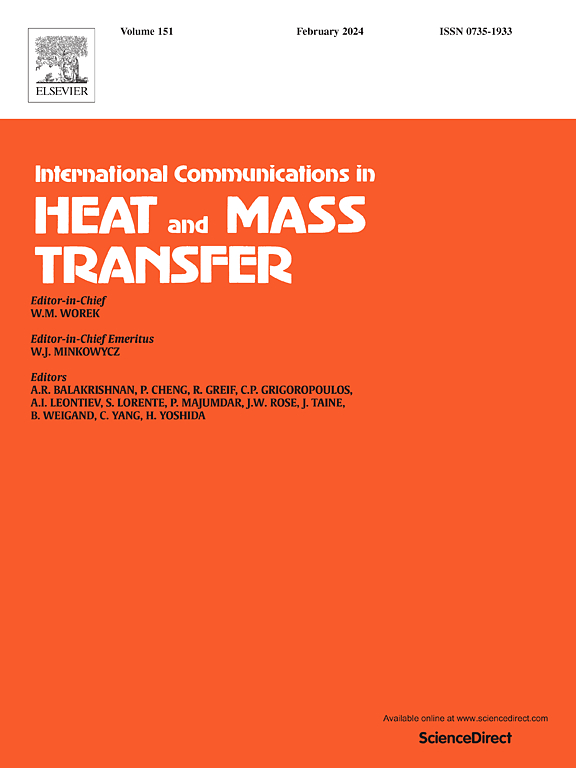Effect of inclination angles on heat transfer characteristics of solid and perforated spiral finned heat exchangers
IF 6.4
2区 工程技术
Q1 MECHANICS
International Communications in Heat and Mass Transfer
Pub Date : 2025-04-01
DOI:10.1016/j.icheatmasstransfer.2025.108920
引用次数: 0
Abstract
Cylinder models integrated with solid/perforated spiral fins are a major direction for heat transfer enhancement in shell-and-tube latent heat exchangers. In practical engineering applications of this system, there exists an operational requirement for different orientations. To investigate how the orientation affects the melting/solidification performance, this paper conducts contrastive experiments for solid and perforated spiral fin heat exchangers (SSHX and PSHX) at five inclination angles (0°, 45°, 90°, 135°, 180°). Solid-liquid evolution and temperature history of the thermal charge/discharge process were recorded, heat transfer characteristics were compared, and energy storage efficiencies were analyzed. The results show that the inclination angle can significantly influence the phase change process of SSHX and PSHX, with the highest values of the indices for PSHX and SSHX at 0°, and the lowest values at 135° and 90°orientation. After the optimization of the inclination angle, the average heat transfer rate and heat flux can be increased by 15.5 % ∼ 84.4 % in thermal charge and 6.3 % ∼ 22.1 % in thermal discharge. Perforations enhance internal convective flows within the heat exchangers across all inclination angles, especially for the vertical orientation with a significant melting rate increase, but such heat transfer contributions are diminished as the angle towards the horizontal orientation. Top-side injection of heat transfer fluid yields better thermal performance than bottom-side injection. The highest energy storage efficiencies for PSHX and SSHX reach 63.4 % and 62.9 %, respectively. These results can provide valuable guidance for practical engineering applications.
求助全文
约1分钟内获得全文
求助全文
来源期刊
CiteScore
11.00
自引率
10.00%
发文量
648
审稿时长
32 days
期刊介绍:
International Communications in Heat and Mass Transfer serves as a world forum for the rapid dissemination of new ideas, new measurement techniques, preliminary findings of ongoing investigations, discussions, and criticisms in the field of heat and mass transfer. Two types of manuscript will be considered for publication: communications (short reports of new work or discussions of work which has already been published) and summaries (abstracts of reports, theses or manuscripts which are too long for publication in full). Together with its companion publication, International Journal of Heat and Mass Transfer, with which it shares the same Board of Editors, this journal is read by research workers and engineers throughout the world.

 求助内容:
求助内容: 应助结果提醒方式:
应助结果提醒方式:


